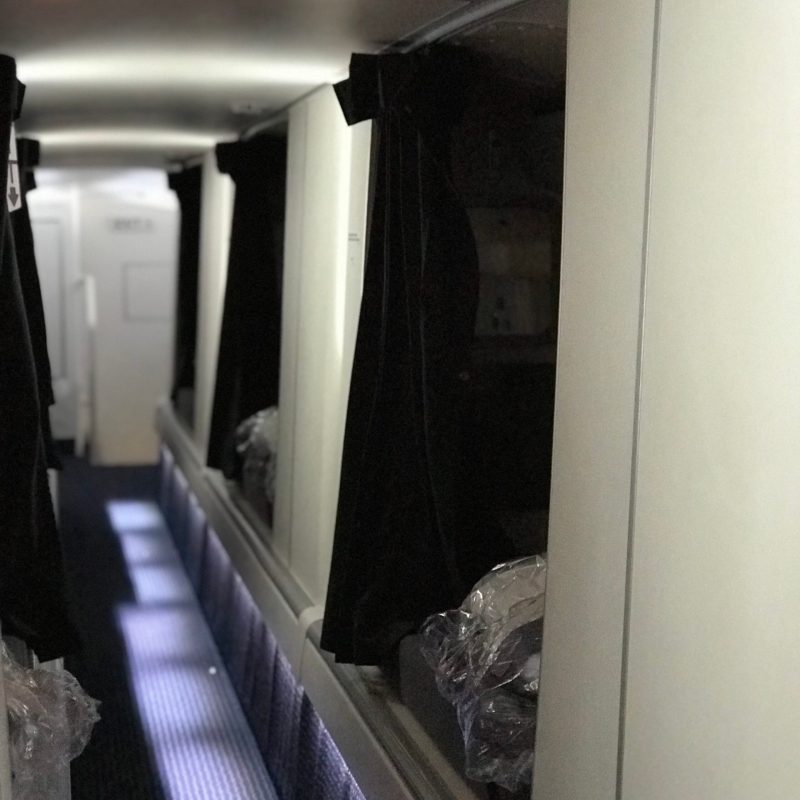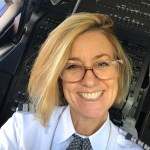
One of my good friends asked me, “How do you have the energy to go out on layovers every time you fly an international trip?” I explained that we sleep on the plane. That statement was followed with wide eyes and raised eyebrows. “You sleep on the plane?” I’m sure she was shocked and concerned that the pilots were sleeping in the cockpit.
Videos by TravelAwaits
I explained that most long-haul aircraft are equipped with rooms for flight crews to rest and nap, occasionally called “condos in the sky.” Others call it “the bunk room” or “the break room,” but the official term is “crew rest area.” Let me pull back the curtain and give you a peek inside of these little-known hidden places on large commercial long-haul jets.

Where Are The Pilots’ Private Quarters?
The airline I work for has two long-haul jets, the Boeing 777 and the Boeing 787. We call the B777-300 the “queen of the fleet.” She is the largest, most comfortable, and has the best crew rest compartments of any aircraft.
There are many regulations and crew staffing required for long-haul flying. The scheduled flight time dictates how many pilots and flight attendants are required on a specific flight. Typically, a long-haul flight scheduled under 12 hours will require three pilots and at a minimum nine to 11 flight attendants. A flight over 12 hours requires four pilots.
The captain usually chooses the break positions for the pilots. There are always two pilots at the flight controls. The pilots rest and take breaks, then relieve the flying pilots equally until the end of the flight. The pursuer, who is the lead flight attendant, coordinates the flight attendants’ breaks based on when the services for the airplane are conducted, seniority, and work position of crew members.

What Is a Bunk Room?
Flight crew members each have their own designated rest areas. Our B777-300 has two very large flight crew rest areas. The pilot rest area is above first class, and the flight attendant break area is near the rear galley. Let me start first with the pilot crew rest area. Behind a discreet door are steep stairs leading into a secret, quiet place to rest. Once on the landing of the stairs, a cabinet opens with mirrors, hangers, and a large storage area for extra linens. The landing is designed for a tall person to stand and not touch the ceiling.
Continue to climb the stairs and you will see two large, leather recliners with more than enough leg space to stretch even the longest of legs. A large video monitor is available to watch one of 300 movies, games, or documentaries. There is lighting, conditioned air, music, and linens available.

Should you choose to have dinner in the bunk area, we can utilize a dumbwaiter to bring food up, easing the navigation up the steep stairs. If you want to catch a nap or just lay down, there are two private bed areas with curtains to create even more privacy. The beds are about 6.5 feet long, about 40 inches wide, and about 36 inches high. We have a crew member who is designated to “make the bunks up” before each flight. I must say we are spoiled with great linens. We have duvets that are wrapped on one side with a white cotton sheet and a gray quilted bedding material.
When it’s your time for a break, you are greeted with a bed that is made! Linens and a duvet are set on the mattress with two white clean pillows. If you want to listen to music, there is a monitor to plug into. You can dim the multiple lights in the bunk to read, relax, or stream movies using the Wi-Fi on the jet to watch on your own tablet. When two pilots share the bunk, one usually gives the other a few minutes of privacy in order to change. On a flight of less than 12 hours, the pilot on break has the entire bunk area to themselves.
There are regulations on how the crew rest areas must be constructed, and each airline can set the configurations when they purchase the aircraft. The current regulations state that areas must be free from intrusive noise, odors, and vibrations that have an effect on sleep. Prior to the creation of specific crew rest areas, a first-class seat was designated for a crew member and a heavy curtain was placed around the seat. Unfortunately, these seats were neither quiet nor private. The seats were located near a galley, and during a service, noise easily spilled through the curtains, and some passengers would poke their heads around the curtains.

Where Do The Flight Attendants Sleep?
The flight attendant bunk area on the B777-300 is quite impressive. It contains eight beds, four on each side, and is above the rear galley. It reminds me of a long bowling alley. The bunk areas each have large heavy curtains for privacy and to reduce noise. Each bunk has its own environmental controls and lighting. These beds are also outfitted with duvets and pillows. All beds are equipped with seat belts for an extra layer of security in case of turbulence. Every bunk area has phones to communicate with the entire aircraft at any time.
Who Gets To Go On Break First?
So just how do we determine when and who gets to go on break, and for how long? For the pilots, we determine how long our actual flight time is minus the take-off procedures and climb. We don’t count any of the taxi time from take-off and landing. We also factor in time for the last pilot on break to be back in the cockpit, well before we start a descent.
If it’s a three-person crew, we divide the entire flight by three. The first pilot, called “first break,” leaves the cockpit and has a predetermined time to return. One slick feature on our flight computer is a “reminder” function. We insert the wake-up time minus about 10 minutes and preset all the breaks. When the timer notifies us, we call the bunk area and give the pilot their 10-minute wake-up courtesy call. It seems to work quite well!
Some pilots request 15 minutes before their break is over, as they might want to freshen up in the restroom or take more time to get dressed. Most pilots remove their uniform shirts and sleep in something more comfortable. During the cold winter months, I jump into a cashmere sweatsuit and really get comfy! Ultimately, all pilots must return, be in uniform, and be at their flight position well before the descent into the destination airport. The purser creates the flight attendants’ breaks with the same logic as the pilots.
The big difference for them is how many services are offered for our passengers on a flight. The purser has to factor in drink services, meals, more drink services, and a pre-landing meal. The coordination can be different for all three classes — first, business, main cabin extra, and coach. Each cabin class has a unique service.

How To Get The Best Sleep In The Bunk
Learning how to manage sleep, breaks, and eating on a long-haul flight is an art. Most seasoned flight crew members have figured out what works best for them to make the most of sleep opportunities. I love to watch movies, but I force myself to lay down and nap even if it isn’t a deep sleep. I pop on my Bose noise canceling headphones and sometimes forget that I am on a jet zooming over 500 miles an hour and wake quite rested. These secret rooms create a safe environment for your flight crews to get needed rest so they can be alert and focused as they arrive at a distant land far from where they took off!
Now You Know!
Next time you are on a long-haul flight, see if you can find the secret doors. Although you can’t visit the rooms, know they are there. The long-haul aircraft of today are designed to travel farther and longer than ever before.
Regulations about crew rest, duty days, flight times, and extremely long flights have created a safe, private, and secure area for flight crews to get the necessary rest to make sure you get to your destination safely. I must admit, first-class sleepers are a fabulous way to take the edge off of a 12-hour flight, but being able to sleep and rest quietly in our “condo in the sky” is the best!
